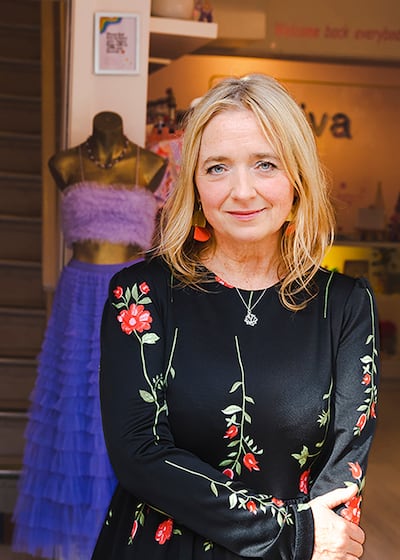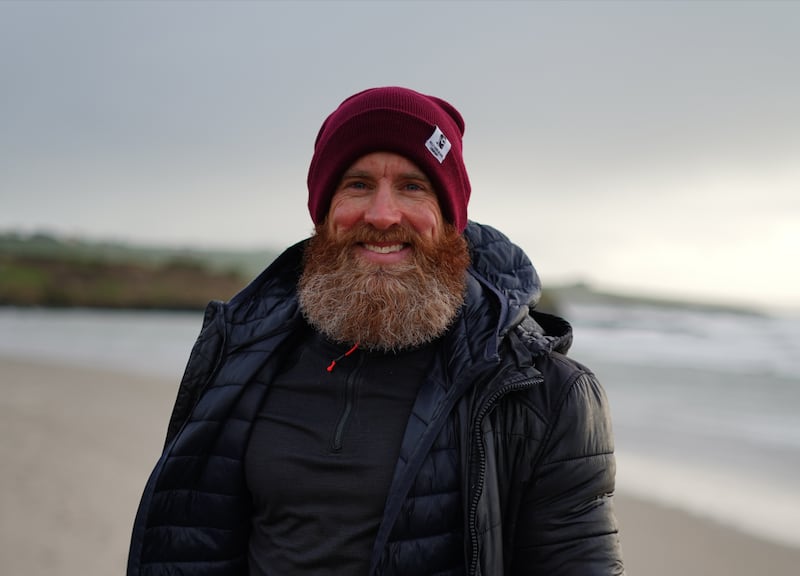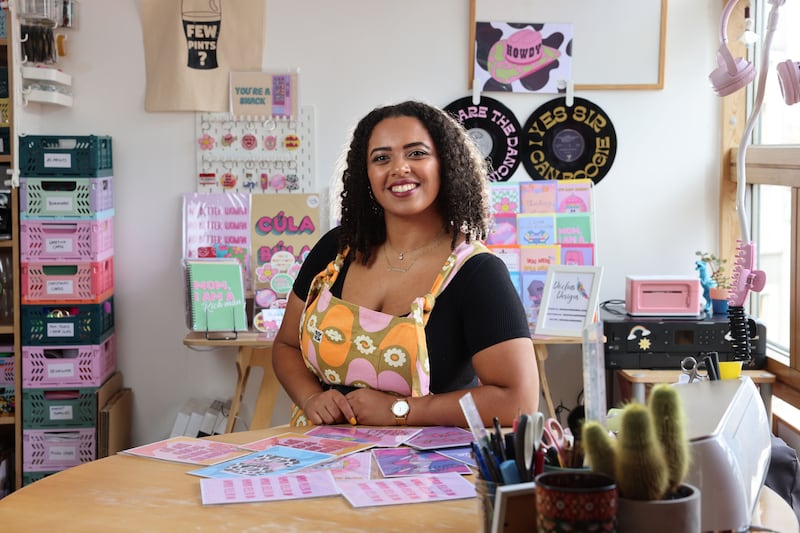Down a little lane in Fairview in north Dublin, you would almost miss the coloured bunting leading to bite-sized boutique Quack & Dirk, where most mornings you will find owner Deirdre Mahon parking her bike, and pulling up the shutter.
A trove of vintage, hand-made and new clothing and accessories, the entire shop is housed in what used to be her mechanic father’s storage shed, and can only accommodate a handful of customers at a time.
But Mahon is one of many entrepreneurs who have used social media as an inexpensive tool to vastly expand their reach, projecting the personal touch of a small business to an online community.
Many of the customers who come through her door tell her they’ve been drawn in by her Instagram page, which has more than 4,000 followers, and features snaps and videos of Mahon, staff and customers modelling the latest stock, as well as a behind-the-scenes look at running the shop day to day.
READ MORE
“I would say 50 per cent of customers that walk in would make some sort of comment like ‘Oh, I saw your video last week’ or ‘I saw you did a photo shoot on Malahide Beach and I love that beach so I clicked into it’ ... There’s definitely a big amount of customers because of that. It would follow through to online [sales] and to walk-ins as well,” she says.
Mahon says that while her business would still be viable without social media, “it wouldn’t be as glittery”.
“It wouldn’t be as popular, and there wouldn’t be as much chat. I love the chat in the background, I love hearing people comment and share – it gives me a bit of a buzz as well,” she says. She says her social media strategy is to avoid thinking too hard about strategy at all.
“On Instagram you can check Insights, and I know I should be doing that, but I don’t. I purposely don’t because I want to be really genuine, honest and organic ... I don’t want it to sound like I’m totally ad hoc, but I think my business plan is to just enjoy it, and everything else will follow,” she says.

In a world of online retail giants with bumper advertising budgets, Emma Johnston is another owner of a small business who has found that gearing her product range to her social media following is a great way to boost sales.
Johnston and her husband, Ross Johnston, own Hunter Paper Co, an independent stationery shop in Ballyhackamore in Belfast.
As well as designing and printing cards on Hunter’s own vintage letter press, Emma says she and Ross specifically order in stock with cult followings online to promote to their more than 6,000 Instagram followers.
“There’s a Japanese brand called Hobonichi that we’ve just got in, and literally just one post about it on Instagram was huge for us. We did a reel about these pencils, Blackwing Pencils, that have a very specific cult following in art circles. It took off on Instagram and we definitely saw a traffic spike from that,” she says.
“Different little products that we do reels on expand our reach. We definitely have more people coming to the shop because of what we put on Instagram, and our online sales benefit from it as well.”
Johnston says curating an Instagram feed that gives a sense of who the couple are and what the shop looks like helps to forge a connection with online customers.
“We just try to keep it natural; our own personality, really. When we’re in the shop we’ll post ‘doors open, we’re here’ for our local customers, let people know that we’re packing up their orders that they’ve placed online, show them around the shop, and just bring people along with us on our day as much as we can,” she says.
“[Instagram] is great for local customers who come into the shop, to keep them updated with what we have, but also to reach a bit further as well, especially for our online customers, being able to give them the feeling of what our shop is like in person.”

Ruth Ní Loinsigh, owner of Om Diva on Drury Street in Dublin, says visitors who flock to her five-storey emporium of fashion, accessories and homeware, including vintage and Irish design, are often excited about what they have seen on her fun-filled Instagram feed.
“We get a lot of people in because they’ve seen [our Instagram]. I think it’s about being genuine, and if you show something on Instagram, if people get excited about an outfit or the images that you put up of the shop, the shop should look and feel as good as people imagine it to be,” she says.
“I want people to feel even more awe when they come into the shop – that’s what we work really hard at doing. There’s no smoke and mirrors, it is what it is, and I think that’s why it works.”
We try to lean away from just pretty girls in pretty dresses; there’s got to be a bit of humour or narrative
— Ruth Ní Loinsigh
Ní Loinsigh has never invested financially into her Instagram page, but has managed to rack up about 22,500 followers by making Om Diva’s posts stand out from the crowd.
“Visually I feel sometimes that social media in general is just a little bit samey-samey. We try to lean away from just pretty girls in pretty dresses; there’s got to be a bit of humour or narrative, or something that will resonate with people,” she says.
“It’s about creating some honest fun and authenticity, without trying too hard to be authentic. I think it’s really just about trying to be real.”
For business owners without their own bricks-and-mortar shop, social media is even more of a lifeline to reach customers without forking out for advertising or relying on stockists.

Colin Murphy, owner of the West Cork Beard Company based in Clonakilty, says his business would be “doomed” if he wasn’t able to connect with people on Instagram, YouTube and TikTok.
“It’s unbelievably essential. Without a doubt, my business wouldn’t be a third of what it is without social media,” he says.
Murphy has garnered almost 9,000 followers on Instagram, for his business that sells hand-made beard products, from balms and butters to oils and waxes. Although, you would have to spend a long time scrolling before you see any of those on his feed.
Murphy prefers to put his own face (and trademark ginger beard) front and centre, with promotion of his products taking a back seat.
Seemingly counterintuitive to the idea of winning over his target market, Murphy’s most successful posts even poke good-natured fun at fellow beard growers, such as about how it seems impossible to eat ice-cream without looking like a messy-faced three-year-old, or to wake up without looking like a mountain goat.
“I’m a big fan of not selling on social media. It’s very rare for me to push or mention any of my products. I will show you some of my products in some of the beard tip videos, but I certainly don’t point at them or tell you what they are,” he says.
“When other human beings are looking at a person in front of them, and if they like what that person is doing and they feel they can connect with that person, it builds a brand a lot better than a faceless product shot.”
I had one video that got 1.5 million views, and it increased my followers from about 3,500 to around 8,000. It increased my sales massively
— Colin Murphy
Murphy says he tries to post a mix of spur-of-the-moment content and quick videos answering customer questions, as well as more high-quality that which could cost about €400 each and take half a day to film.
But even that small investment can pay dividends, as he says it takes only a single hit video to reap large returns.
“I had one video that got 1.5 million views, and it increased my followers from about 3,500 to around 8,000,” he says. “It increased my sales massively. That one video, which I never even paid to market, got me everything I needed for almost the whole year. That’s the beauty of social media, you only need one hit.”

Jasmine Feehan recently left her job as a solicitor to focus full time on her small business, Dóchas Designs. Her distinctly Irish designs incorporate pop culture and cúpla focail across everything from art prints to homeware.
“Without social media I think I would struggle to keep going, I think it’s the main driver towards my sales and also my main source of community,” she says.
Since June, Feehan has been working full time on building her personal brand on social media, to her more than 2,000 followers across Instagram, TikTok and Pinterest.
“I’m really enthusiastic about putting my face out there, there’s a lot of other illustrators and small businesses who don’t quite feel comfortable with that, but I think it’s really important. My target audience is people like me. My products are all tailored towards people of a similar age and similar interests, so I feel like people can connect a lot more with a brand [when they see] the person behind it.”
You see a lot of tips online about how to blow up, to go viral. A lot of those are great if you’re trying to beat the algorithm, but what I’m trying to do is cultivate a community
— Jasmine Feehan
She too has experienced the viral power of an online hit, and the amplified impact it can have on sales. An Instagram post featuring one of her prints recently “blew up”, shared at first by her followers but then spreading across the stories of Instagram users in the US, and spiking sales to 50 times her business’s monthly average.
US customers also stuck around, as her following is now about a quarter Irish and a quarter American, compared with 60 per cent Irish and 10 per cent from the US beforehand.
“Once I started taking [social media] a lot more seriously, that was the kind of explosion I got to see,” she says.
However, she advises that for small business owners looking to break into social media, the focus should be on cultivating a loyal community, rather than chasing fleeting viral moments.
“You see a lot of tips online about how to blow up, to go viral. I think a lot of those are great if you’re trying to beat the algorithm, absolutely, but what I’m trying to do is cultivate a community. You’re not going to go viral from that, but you are going to build a loyal brand following.”















